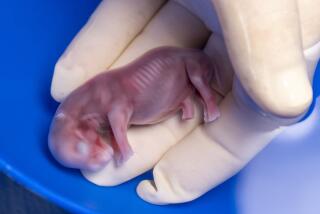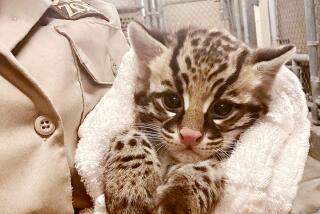Ah, the Pitter-Patter of Little Flippers . . .
Penguin keepers know that a good emperor is hard to find.
The first successful hatching of the emperor penguin species in five years took place last month at Sea World, park officials announced Wednesday.
Although the chick arrived Sept. 16, officials waited to release news of the hatchling because it appeared sickly and had a slim chance for survival, park spokesman Fred Jacobs said.
The chick now weighs a healthy 2.4 pounds, measures 8 inches tall and is on its way to growing to full size--an average of 3 1/2 feet and up to 100 pounds.
Park officials said the sex of the penguin cannot be determined until the bird reaches adulthood and beings to exhibit mating behavior.
The chick is the 12th to be hatched at Sea World, which has had the only successful captive-breeding program for emperors, according to park officials.
Breeders say they are encouraged by the event because it indicates the birds are comfortable in their 50-by-100-foot, refrigerated “polar unit.”
“If the animals were not content in this environment, they wouldn’t breed,” said Burke Stuchlick, a senior bird keeper at Sea World. “Like people, they are very particular. They don’t just breed anywhere.”
In about three months, the new bird will be introduced to the colony of 44 other emperor penguins at the aquatic theme park. The population in the wild is considered stable, at more than 100,000.
Part of the captive-breeding challenge lies in the hatching process itself: The female penguin lays the egg, makes sure it doesn’t crack when it hits the ice, then flips the avocado-size ovoid over to the male, Stuchlick said. The male rests the egg on top of his feet, folds his stomach fat over it, then stands still until it hatches 64 or so days later.
The hatching period is always smack in the middle of the winter in the Antarctic, where temperatures can drop 70 degrees below zero. During that time, the egg-burdened male cannot move freely, so he goes without food during the incubation, Stuchlick said.
While the male is trying to keep the egg warm, the female goes off and feeds. She breezes back to the roost when the hatchling makes its debut, Stuchlick said, then takes over the feeding duties.
In this case, park officials said, the egg was taken by keepers before hatching and the chick is being fed by hand because the mating couple were inexperienced as parents.
More to Read
Sign up for Essential California
The most important California stories and recommendations in your inbox every morning.
You may occasionally receive promotional content from the Los Angeles Times.










